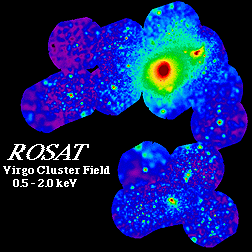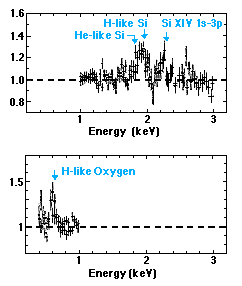|
|
Abundances in clusters of galaxies
How have carbon, oxygen, and other elements been created and distributed?
This is one of the most fundamental questions in astrophysics, touching on
the origin of the Earth and life as we know it. It is generally agreed that
hydrogen and helium formed shortly after the Big Bang, when the Universe
was hot; all other elements were created in stars, and distributed by
supernova explosions. However, we still have a lot to learn of
the details of the chemical evolution (how much of different elements
was created and how far these propagated to different places at different
times in the history of the Universe). One particular question is the
relative importance of two types of supernovae, type I and type II,
at different times. ASCA observations of clusters of galaxies have
provided a valuable clue for this continuing study.

Clusters of galaxies are filled with X-ray emitting hot gas. The gas is
'enriched' with carbon, oxygen, and other elements due to supernova explosions
in the member galaxies, but, due to the large distances involved, reflects the
early conditions in the history of the Universe. Since the condition of this
gas is simple (unlike in accreting binaries),
the abundances of elements can be estimated by measuring the strengths of the
characteristic lines of these elements.

|
Examples of ASCA spectra of clusters of galaxies, expressed as ratio of
observed data over the continuum model. Individual emission lines are clearly
seen; the strengths of these lines (together with temperature measured from
the continuum) indicates the abundances of these elements.
|
Before ASCA, it was known that the hot gas in clusters had more iron than
was predicted by the standard model of supernovae. It was impossible to tell
which was under predicted in the model, the number of Type I supernovae or that
of Type II supernovae. Type II supernovae are how stars much more massive
than the Sun end their lives; Type I are thought to be accreting white dwarfs.
The two types produce different elements in different proportions, which can
now be measured with ASCA data. Because the pattern of abundances of the hot
cluster gas matches those produced by Type II supernovae (see below), we now
know that the extra supernovae that were previously not predicted were of
Type II. This in turn implies that there were more massive stars in the early
Universe than previously thought.

Show me a viewgraph of Abundances in Clusters of Galaxies
|
